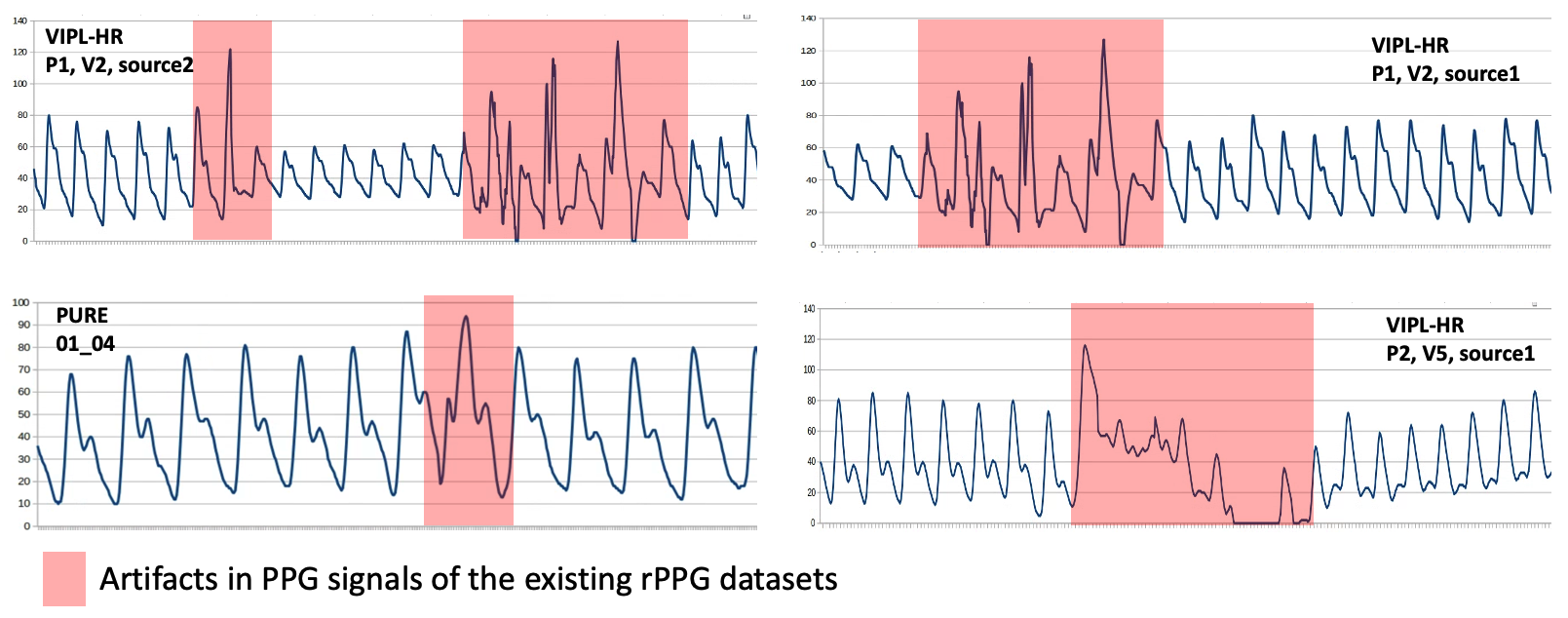iBVP Dataset: RGB-Thermal rPPG Dataset with High Resolution Signal Quality Labels
Remote photoplethysmography (rPPG) promises contactless vital sign monitoring across healthcare, human-computer interaction, and wellness applications. Yet a fundamental challenge persists: existing datasets largely neglect ground-truth signal quality assessment, leaving researchers unable to develop algorithms that can reliably distinguish high-quality physiological signals from noise-corrupted data. Our work addresses this gap.

Figure 1: Samples of ground-truth PPG signals from existing datasets showing artifacts in existing dataset.
Dataset Innovation and Technical Specifications
The iBVP dataset directly addresses this critical gap by providing high-resolution signal quality labels alongside comprehensive multi-modal recordings captured across realistic psycho-physiological variations.
Comprehensive Data Acquisition Protocol

Figure 2: Experimental setup showing synchronized RGB-thermal acquisition at 1m distance with ear-based PPG ground truth collection across four distinct psycho-physiological conditions.
The data acquisition protocol induces realistic variations through four carefully designed conditions:
- Condition A: Rhythmic slow breathing and rest (baseline physiological state)
- Condition B: Easy math task (mild cognitive load)
- Condition C: Difficult math task (high cognitive stress)
- Condition D: Guided head movement (motion artifact challenges)
This protocol ensures comprehensive coverage of real-world variations in both physiological states and motion artifacts that rPPG systems must handle in practical deployments.
Signal Quality Labeling
The dataset provides dual signal quality assessment:
Manual Quality Labels (SQ1, SQ2):
- Expert-annotated quality scores (labelled for every 0.5 second segment, extrapolated as per-sample label)
- Ground truth for quality assessment algorithms
SQA-PhysMD Automated Labels:
- Dense per-sample quality scores
- Trained and validated quality assessment model
This dual approach enables both algorithm development and validation for signal quality assessment—a critical capability missing from existing datasets.
Table 1: iBVP Dataset Technical Specifications
| Specification | Details |
|---|---|
| Participants | 31 subjects |
| Total Sessions | 124 recordings (3 minutes each) |
| Total Duration | 372 minutes (~6 hours) |
| Video Modalities | RGB (640×480) + Thermal (640×512) |
| Frame Rate | 30 FPS synchronized |
| Ground Truth | Ear-based PPG acquisition |
| Signal Quality | Manual + automated (SQA-PhysMD) labels |
| Dataset Size | ~400 GB (compressed) |
Dataset Structure and Organization
Folder Structure
iBVP_Dataset/
├── p01_a/
│ ├── p01_a_rgb/ # RGB frames (.bmp)
│ ├── p01_a_t/ # Thermal frames (.raw)
│ └── p01_a_bvp.csv # PPG + quality labels
├── p01_b/
│ ├── p01_b_rgb/
│ ├── p01_b_t/
│ └── p01_b_bvp.csv
└── ...
Data Files Content
Table 3: CSV File Structure (pii_x_bvp.csv)
| Column | Description |
|---|---|
| BVP | Filtered PPG signals (30 FPS) |
| SQPhysMD | Automated quality scores |
| SQ1 | Manual quality labels (Annotator 1) |
| SQ2 | Manual quality labels (Annotator 2) |
| Perfusion_Value | Computed perfusion index |
Research Impact and Global Adoption
Since release in April 2024 (until June 2025):
- 40+ research teams globally utilizing the dataset
- 5,000+ article views indicating strong community engagement
- Multiple high-impact publications leveraging signal quality annotations
Dataset Access and Usage Guidelines
Academic Access Requirements
The iBVP dataset is available exclusively for academic research purposes through a formal request process:
- Download EULA: Complete the End-User License Agreement
- Academic Supervisor Signature: In case of students, EULA must be signed by academic supervisors
- Research Description: Include research objectives and dataset usage plans
Privacy and Ethical Considerations
Confidential Participants: Seven participants (p08, p10, p13, p16, p29, p31, p33) provided limited consent:
- Their data is stored in separate “Confidential_No-media-use” folder
- Images of these participants SHALL NOT be used for any publication.
Conclusion
With comprehensive multi-modal recordings, realistic experimental protocols, and signal quality labeling, iBVP dataset enables the development of robust contactless monitoring systems ready for real-world deployment.
Dataset Access: Submit signed EULA to request academic access
Paper: Electronics 2024
Citation:
@article{joshi2024ibvp,
title={iBVP Dataset: RGB-Thermal rPPG Dataset with High Resolution Signal Quality Labels},
author={Joshi, Jitesh and Cho, Youngjun},
journal={Electronics},
publisher={MDPI},
volume={13},
year={2024},
number={7},
article-number={1334},
url={https://www.mdpi.com/2079-9292/13/7/1334},
issn={2079-9292},
doi={10.3390/electronics13071334}
}
@article{joshi2023physiokit,
title={PhysioKit: An Open-Source, Low-Cost Physiological Computing Toolkit for Single-and Multi-User Studies},
author={Joshi, Jitesh and Wang, Katherine and Cho, Youngjun},
journal={Sensors},
publisher={MDPI},
volume={23},
number={19},
article-number={8244},
year={2023},
url={https://www.mdpi.com/1424-8220/23/19/8244},
issn={1424-8220},
doi={10.3390/s23198244}
}
This work was conducted at the Department of Computer Science, University College London, under the supervision of Prof. Youngjun Cho. Jitesh Joshi was fully supported with international studentship that was secured by Prof. Cho
For questions or collaborations, please contact: jitesh.joshi.20@ucl.ac.uk and/or youngjun.cho@ucl.ac.uk